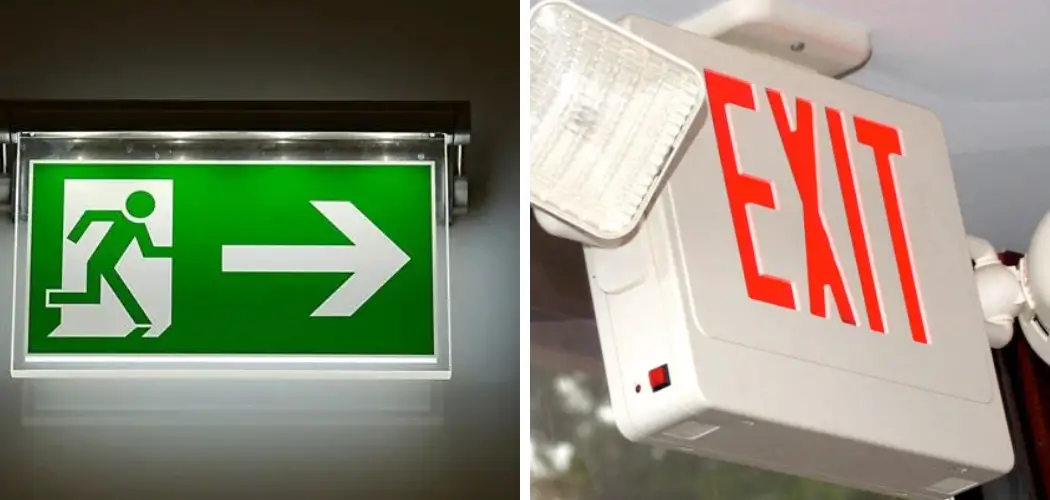Ensuring the functionality of exit signs is a critical aspect of maintaining safety within any building or facility. These signs are designed to guide occupants safely out of buildings during emergencies, including fires and power outages. Regular testing is not only a safety measure but also a regulatory requirement in many jurisdictions.
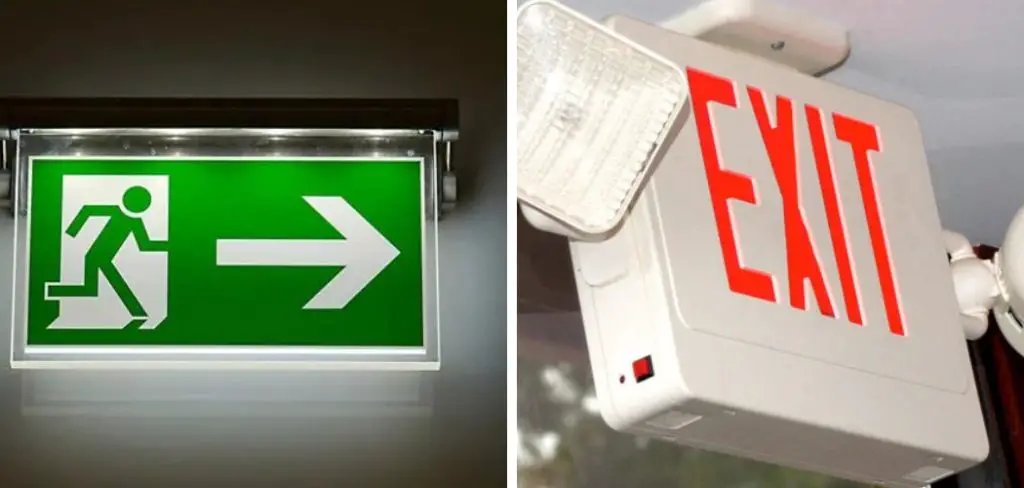
This document provides a comprehensive guide on how to test exit signs effectively, ensuring they function correctly when they are most needed. By adhering to these practices, facility managers can ensure the safety of all building occupants and comply with local safety regulations.
What is an Exit Sign?
An exit sign is a visual indicator that shows the location of emergency exits in a building. These signs are typically installed above doorways or along designated evacuation routes and can be either illuminated or non-illuminated. Illuminated exit signs use energy-efficient LED lights to stay lit at all times, providing clear visibility in case of emergencies. The purpose of an exit sign is to guide building occupants toward a safe exit during emergencies and prevent panic or confusion.
Why Test Exit Signs?
Exit signs are designed to function as a crucial safety measure in emergency situations. Without proper testing, there is no way to guarantee that they will work correctly during an actual emergency. Regular testing can identify any issues with the sign’s functionality and allow for necessary repairs or replacements before it becomes critical.
In addition to ensuring the safety of building occupants, regular testing of exit signs is also a regulatory requirement in many jurisdictions. Building codes and fire safety regulations often mandate that exit signs be tested periodically to maintain compliance.
How Often Should Exit Signs Be Tested?
The frequency of exit sign testing can vary depending on the jurisdiction and type of building. Generally, it is recommended to test illuminated exit signs at least once a month and non-illuminated signs at least once a year. However, building managers should always check their local fire codes and regulations to determine the specific testing requirements for their area.

Needed Materials
In order to test exit signs effectively, you will need the following materials:
A Ladder or Step Stool (If Needed)
Depending on the height of the exit sign, a ladder or step stool may be required to access it for testing. It is essential to follow all safety protocols when using a ladder, such as ensuring it is on stable ground and having a spotter present.
A Test Button or Tool
Most modern exit signs come equipped with a test button that can be pressed to check its functionality. If your sign does not have this feature, you may need to use a voltage tester or other specialized tool.
10 Step-by-step Guidelines on How to Test Exit Signs
Step 1: Notify Building Occupants
Before testing exit signs, it is essential to inform all building occupants about the test. This will prevent confusion or panic and ensure that everyone is aware of the testing process. You can do this through email, flyers, or any other method of communication commonly used in your facility. The notification should also include the date and time of the test.
It is best to conduct the test during off-peak hours to minimize disruption. But, if it is not possible, make sure to notify occupants of the potential disruption. You should also inform building management or any relevant authorities about the testing.
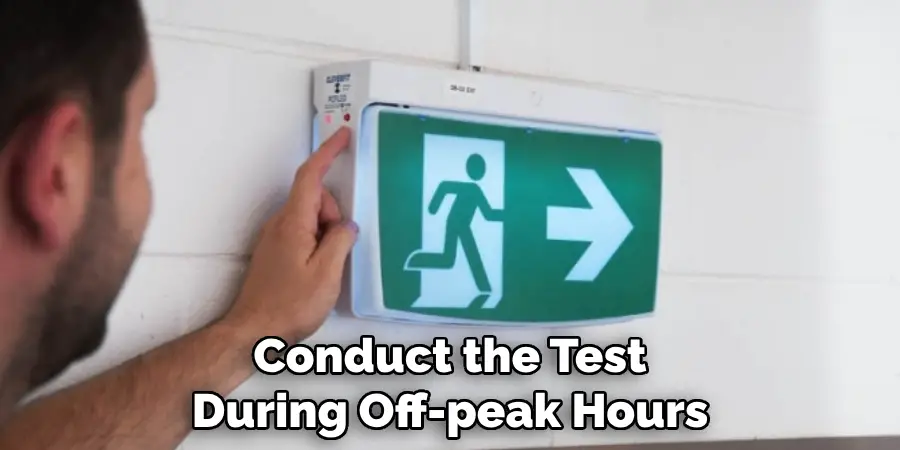
Step 2: Check for Physical Damage
Inspect the exit sign for any physical damage that may affect its functionality. This includes cracks, loose wiring, or any other visible signs of wear and tear. If any damage is found, the sign should be replaced immediately. It is essential to keep spare exit signs on hand for quick replacements.
You can also contact a professional electrician for repairs. The test button or tool should be used to activate the sign’s emergency lights. If the sign does not light up, it may need new batteries or replacement. It is also important to check the backup power supply, such as batteries or a generator, for non-illuminated exit signs.
Step 3: Check for Proper Mounting and Positioning
Confirm that the exit sign is mounted correctly and in the proper position. It should be installed above doorways or along designated evacuation routes, with no obstructions blocking its visibility. If the sign is not mounted correctly, it should be repositioned or adjusted. You can also contact a professional for assistance with installation. However, if the sign is mounted correctly but still not functioning properly, it may need replacement. You can also check the wiring and connections to ensure they are secure. It is important to follow all safety protocols and turn off power before handling wiring.
Step 4: Test Illumination
For illuminated exit signs, press the test button or use the specialized tool to check if the sign’s emergency lights are functioning correctly. The lights should turn on and stay illuminated until manually turned off. If the lights flicker or do not turn on at all, the sign may need new batteries or replacement. But if the lights stay on for less than an hour, it may indicate a wiring issue or faulty backup power supply. The sign should be replaced or repaired immediately. It is also recommended to monitor the sign’s illumination for a full hour, as this is typically the duration of most emergency situations.
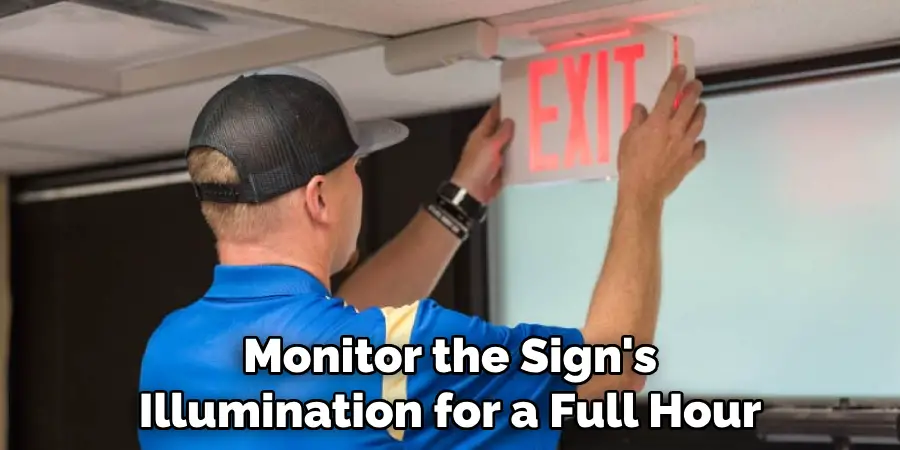
Step 5: Test Battery Backup
For exit signs with battery backup systems, it is important to test the backup power supply. This can be done by unplugging the sign from its main power source and checking if the emergency lights still stay illuminated. If they do not, the batteries may need replacement. It is essential to test the backup power supply regularly and replace batteries every 2-5 years, depending on their type and manufacturer’s instructions. The backup power supply should also be tested after any major power outages. You can also contact a professional for assistance with battery replacements and backups.
Step 6: Test Non-Illuminated Exit Signs
For non-illuminated exit signs, use the test button or tool to make sure it is functioning correctly. The sign should be in good condition and mounted in the proper position but without any emergency lights. If the sign does not display properly, it may require replacement. You can also check the wiring and connections for any issues. It is important to have spare exit signs on hand for quick replacements if necessary. But if the sign is functioning correctly, it may not require testing for another year. The date of the last test should be noted for future reference.
Step 7: Check for Proper Signage
It is essential to ensure that all exit signs have proper signage and are easily visible. This includes making sure there are no obstructions blocking the sign’s visibility and that the letters and arrows on the sign are clear and legible. If any issues are found, the sign should be replaced or adjusted accordingly.
However, if the sign appears to be functioning correctly, it may not require replacement. It is important to keep spare exit signs on hand for quick replacements if necessary. You can also contact a professional for assistance with installation or repairs. The backup power supply should also be tested after any major power outages.
Step 8: Test Emergency Lighting System (If Applicable)
Some buildings may have an emergency lighting system that works in conjunction with exit signs. It is important to test this system regularly as well, following the manufacturer’s instructions. This may involve turning off all main power sources and checking if the emergency lights turn on. If any issues are found, contact a professional for repairs or replacements.
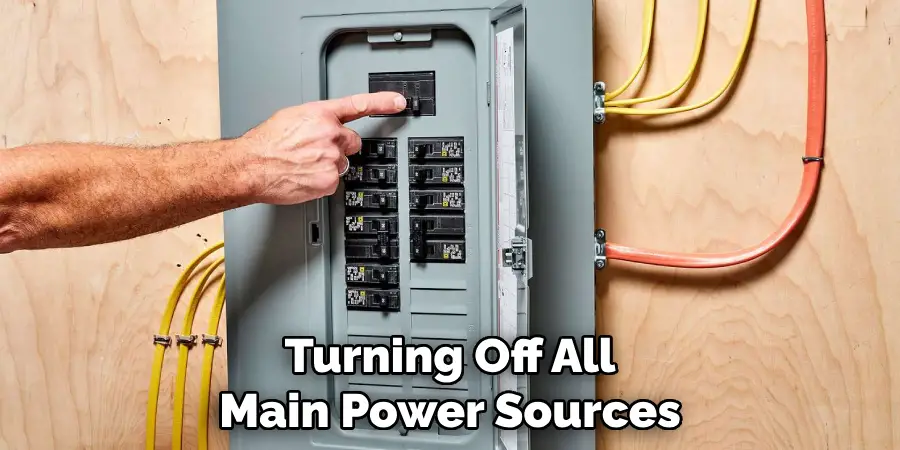
The emergency lighting system should also be tested after any major power outages. You can also keep spare emergency lighting systems on hand for quick replacements if necessary. It is essential to have a professional electrician install and maintain these systems.
Step 9: Notify Building Occupants of Test Completion
After completing the exit sign testing, it is important to inform building occupants that the test has been completed. This will help alleviate any confusion or panic and assure them that the exit signs are functioning correctly. You can also use this opportunity to remind occupants of the importance of following emergency evacuation procedures and identifying designated exits.
If any issues are found during the testing, it is important to inform building management and schedule repairs or replacements accordingly. You can also conduct post-test evaluations to identify any potential improvements in the testing process.
Step 10: Document Test Results
It is crucial to keep a record of all exit sign tests and their results. This will help track any recurring issues and ensure that all signs are functioning correctly. You can create a simple spreadsheet or use specialized software for this purpose. The record should also include the date of the test, any issues found, and actions taken to resolve them. This documentation can also serve as proof of compliance during safety inspections or audits.
Following these steps regularly will ensure that all exit signs in a building are functional and compliant with safety regulations. In case of any issues or concerns, it is best to contact a professional for assistance. Remember, properly functioning exit signs can save lives during an emergency evacuation. Always make sure to take the necessary precautions to keep them in top condition. Stay safe!
Troubleshooting and Maintenance: What to do if Issues Arise
Despite regular testing and maintenance, it is possible for issues to arise with exit signs. Here are some common problems and solutions to troubleshoot them:
Sign Not Working at All:
Check the main power source and ensure that it is properly connected. If the sign has a battery backup, check the batteries’ condition and replace them if necessary. If the sign is still not working, it may need replacement.
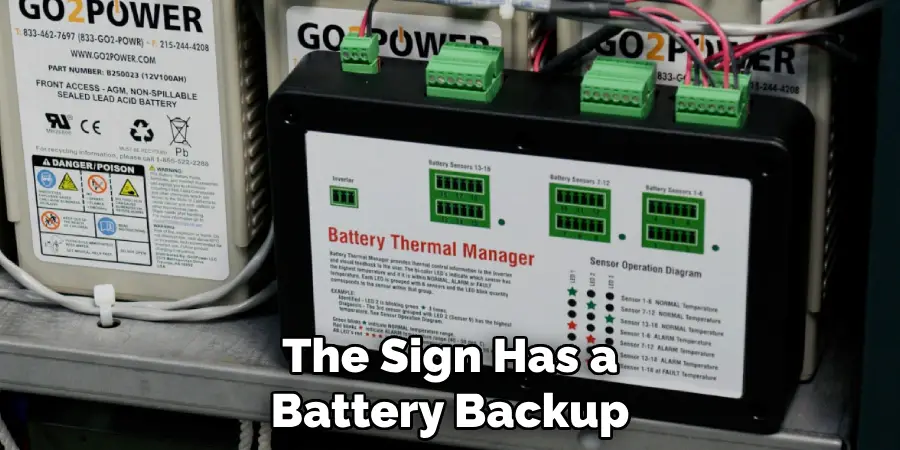
Sign Flickering:
This may indicate a wiring issue or faulty backup power supply. Contact a professional for assistance with repairs or replacements.
Sign Not Illuminated During Power Outage:
For signs with battery backups, check the batteries’ condition and replace them if necessary. For emergency lighting systems, contact a professional for assistance with repairs or replacements.
Sign Not Displaying Properly:
Check for obstructions blocking the sign’s visibility and adjust if necessary. If the letters or arrows are unclear, the sign may need replacement.
If any issues persist despite troubleshooting, it is best to contact a professional for assistance. Regular maintenance and testing can prevent most problems, but it is important to address any issues promptly to ensure the safety of building occupants.
Importance of Proper Exit Sign Testing
The importance of proper exit sign testing cannot be overstated. In emergencies, such as fires or power outages, clearly visible and functional exit signs are vital for guiding occupants safely out of the building. Regular testing and maintenance guarantee that these signs perform as expected during crucial moments, significantly reducing the risk of panic or injury.
Furthermore, adhering to safety regulations through diligent testing helps avoid legal and financial repercussions that may arise from non-compliance. In essence, the lives and well-being of building occupants heavily depend on the reliability of these signs, underscoring the critical role that routine testing plays in ensuring a safe evacuation process.
Resources and Tools for Exit Sign Testing
There are various resources and tools available to assist with exit sign testing and maintenance. Some options include:
Exit Sign Testing Kits:
These kits typically come with all the necessary tools and instructions for conducting thorough tests.
Spreadsheet or Software:
As mentioned earlier, keeping a record of exit sign tests is crucial for tracking issues and ensuring compliance. Using a spreadsheet or specialized software can make this process more organized and efficient.
Professional Services:
In cases where building management or personnel are not equipped to conduct exit sign testing, it is best to seek professional assistance. These experts have the knowledge, tools, and experience to ensure that all signs are functioning correctly and in compliance with safety regulations.
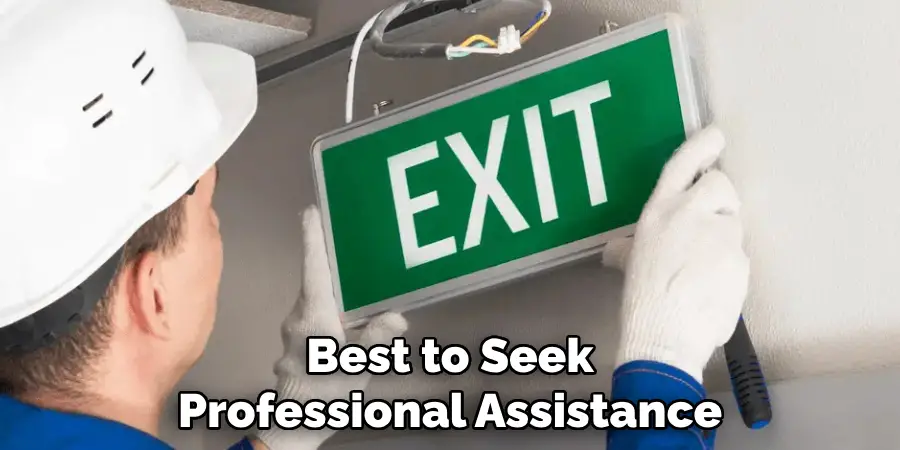
Additional Tips
- Routinely Check for Any Signs of Wear or Damage on Exit Signs, Such as Faded Letters or Broken Bulbs.
- Regularly Dust and Clean Exit Signs to Ensure Maximum Visibility.
- Conduct Monthly Visual Inspections of All Exit Signs to Identify Any Potential Issues.
- Train Building Personnel on Proper Emergency Evacuation Procedures and the Location of Designated Exits. Instruct Them to Report Any Signs That Are Not Functioning Correctly.
- Keep Spare Batteries and Replacement Exit Signs on Hand for Emergencies or Unexpected Failures. Always Replace Faulty Exit Signs Immediately.
- Stay Updated on Safety Regulations and Requirements to Ensure Compliance With the Latest Standards.
- Always Follow the Manufacturer’s Instructions and Safety Precautions When Conducting Exit Sign Testing.
- If Unsure About Any Aspect of Exit Sign Maintenance or Testing, Consult a Professional for Guidance. Safety Should Always Be the Top Priority.
- Lastly, Always Plan and Practice Emergency Evacuation Procedures With Building Occupants to Ensure a Safe and Efficient Evacuation Process. Exit Signs Are Only One Component of Overall Emergency Preparedness.
Frequently Asked Questions
Q: How Often Should Exit Signs Be Tested?
A: Exit signs should be tested at least once a month. You should also perform thorough tests every six months, following the manufacturer’s instructions. It is also important to test after any major power outages or repairs.
Q: Can I Conduct Exit Sign Testing Myself?
A: Yes, building management or designated personnel can perform exit sign testing as long as they follow proper guidelines and procedures. However, professional assistance may be necessary in certain situations.
Q: Are There Any Regulations Regarding Exit Sign Testing?
A: Yes, various safety regulations such as NFPA 101 and OSHA, require regular testing and maintenance of exit signs in commercial and public buildings. Failure to comply with these regulations can result in penalties or legal consequences.
Q: What Should I Do if an Exit Sign is Not Working Properly?
A: Troubleshoot the issue and contact a professional for assistance if necessary. Regular testing can help identify any issues early on, allowing for prompt repairs or replacements. It is crucial to address any problems promptly to ensure the safety of building occupants.
Q: Can I Use Battery-Powered Exit Signs?
A: Yes, battery-powered exit signs are a viable option for emergency lighting. However, they must be regularly tested and maintained to ensure proper functionality in emergencies. It is recommended to have a mix of both battery-powered and hardwired exit signs for added reliability.
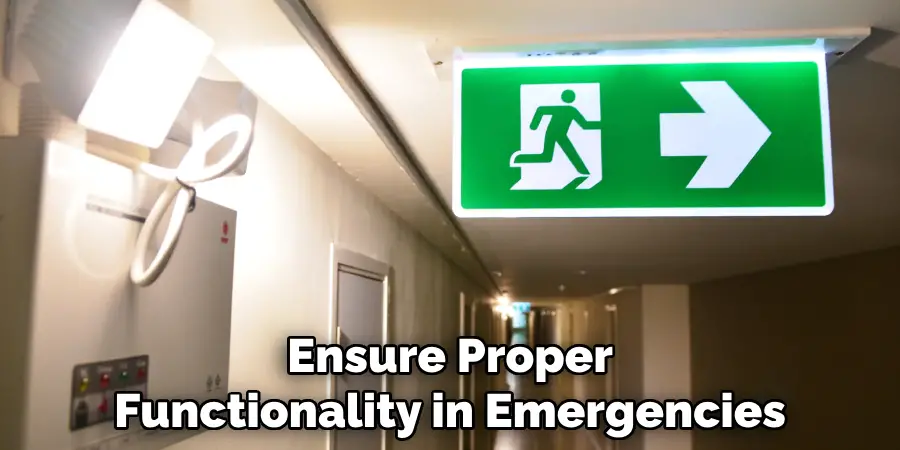
Conclusion
In conclusion, regular testing of exit signs is an essential practice in ensuring the safety and preparedness of any facility. By following the guidelines outlined on how to test exit signs in this document, facility managers can play a crucial role in maintaining a safe environment for all occupants. It’s important to remember that these tests not only meet regulatory requirements but are fundamental to the overall safety strategy of any building. Regular maintenance and testing can ultimately save lives in the event of an emergency, highlighting the importance of these procedures.

